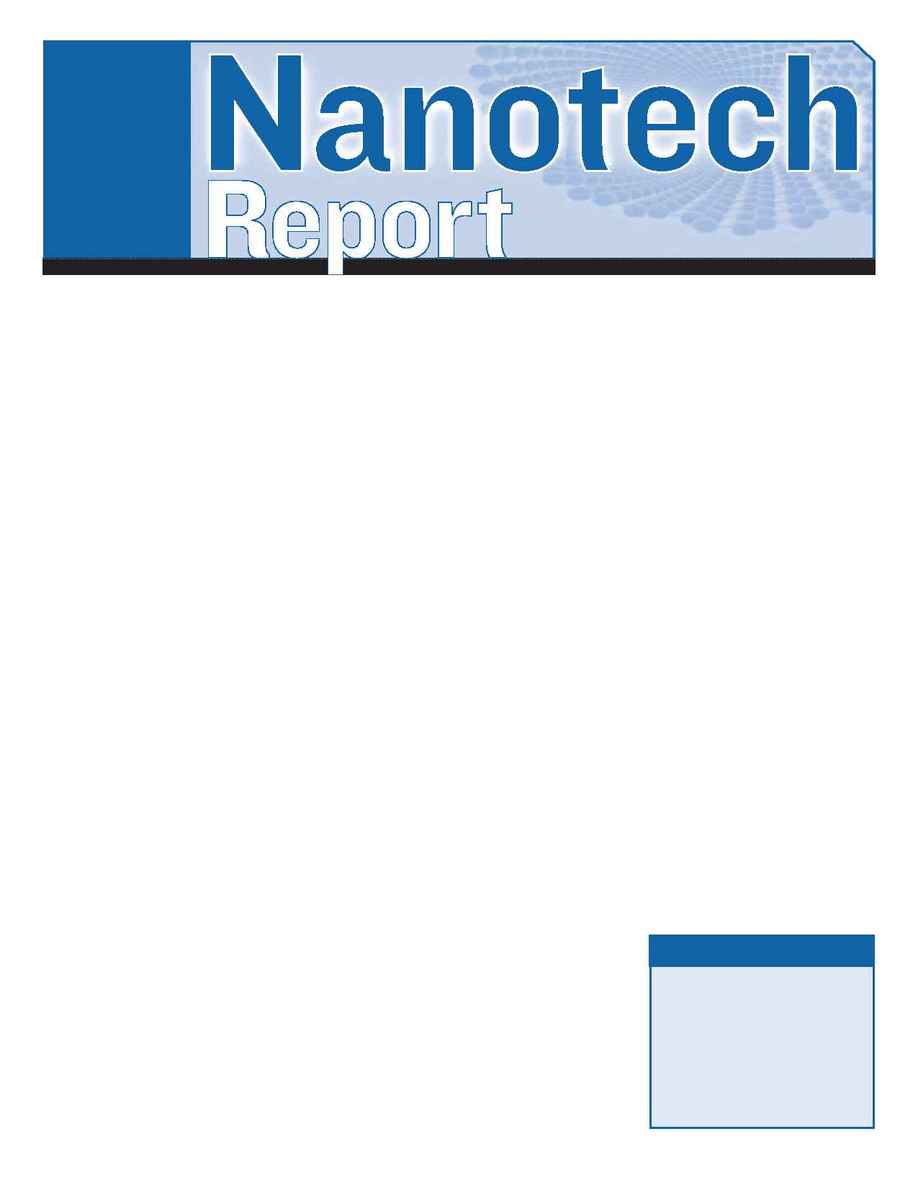
M
ost of you are already familiar with Nucryst Pharmaceuti-
cals [NCST], from the pages of this newsletter. I first wrote
about Nucrsyt as a Company to Watch in August 2004. The
Wakefield,Massachusetts-based subsidiary of Westaim Corp
[WEDX] develops and manufactures nano-enhanced wound man-
agement products. At the end of last year, Nucryst had an initial pub-
lic offering of 4.5 million shares priced at $10 each. The stock has
since been added to the $110 million PowerShares Lux Nanotech
ETF [PXN] and is rated a Buy by three brokerage firms. In the last
three months, the stock has gained 20% and is trading at $12 per
share. Unlike many nanotech firms, Nucryst is a solid operation with
viable products. But the more important question is, is it a worthy
stock investment?
Nucryst has been around for 15 years, long before all the nano-
hype. Most recently the company developed a method for taking sil-
ver (which has long been known to have significant medicinal bene-
fits), breaking it down using a patented process, and then building it
back up into silver nanocrystals atom by atom. At the nanoscale, sil-
ver's therapeutic effects become several times more potent. The in-
creased surface area means faster chemical reactions, greater solubil-
ity, and a sustained release of silver ions, which kill over 150
pathogens without any harmful side effects.
Nucryst packaged its nanocrystalline silver, which goes by the
name Silcryst, into dressings for serious wounds and burns, and in
2001 it struck a deal with Smith & Nephew plc [SNN], Europe's
second-largest medical equipment firm and one of the major play-
ers in the wound management industry on a global scale. The deal
has meant that Smith & Nephew sells, distributes, and markets the
dressings under the name Acticoat, and that Nucryst is the exclu-
sive manufacturer of Acticoat products. Nucryst receives royalties
and manufacturing payments, and is eligible for up to $56.5 mil-
lion in milestone payments, $19 million of which they've collected
so far. Smith & Nephew currently sells Acticoat in 30 countries
around the world.
The fact that Nucryst has received its milestone payments is a tes-
tament to Acticoat's viability. It's remained an important component
of Smith & Nephew's arsenal of wound care products for five years,
so it's already well-known as effective wound care and is used in
burn centers and hospitals around the world. The science behind the
product is well-tested and well-understood. Acticoat comes in a va-
riety of formulations designed to meet the needs of different injury
levels. The sustained release of silver means that a patient has to change
dressings far less often than they would with alternative products, sig-
nificantly reducing the pain and setbacks to the wound that come with
dressing changes
--
a fact that can have a big impact on patient satisfac-
tion, which ultimately determines a product's future.
Nucryst earned record revenues of $18.6 million from its Silcryst
technology, an increase of 27% from the previous year. According to
Kalorama Information, specializing in business intelligence and
market research in the life sciences, approximately 27 million burn
cases requiring professional treatment occur worldwide each year,
with at least 7 million requiring hospitalization. The wound care in-
dustry is estimated at over $1.5 billion globally. Moreover, the in-
creasing number of cases in which bacteria evolve resistances to ex-
isting drugs is leading to a demand for products that utilize
antimicrobial silver. That's because the nanosilver kills bacteria so
fast (within 30 minutes) that it's almost impossible for the bacteria
to build up any kind of tolerance to the treatment.
Nucryst's relationship with Smith & Nephew is a solid one and I
don't foresee any major problems with this important strategic al-
liance. Although wound management makes up only a quarter of
Smith & Nephew's revenue (endoscopy makes up another quarter
while their main focus is in orthopaedics), Acticoat is a significant
product for them because of its potential for considerable growth.
According to Michael King, an analyst at Nomura Code Securities in
London who covers Smith & Nephew, Acticoat sales make up per-
haps 13% of total divisional sales and it's one of the top two single
products management talks about. Acticoat is exhibiting 25%-30%
percent growth per year. The worldwide market for advanced wound
care products is probably growing at about 7%-8%, according to
King. Thus Acticoat is rapidly gaining market share.
Beyond its relationship
with Smith & Nephew, Nu-
cryst has plenty of other op-
portunities for growth. Its
built up a strong IP portfolio,
holding over 14 issued US
patents
--
including the Sil-
cryst patents which it owns
exclusively. The patents cover
its manufacturing process, as
well as products and compo-
Will Nucryst's Cures Heal Nano Investors? . . . 1
NVEC: An IP Company with Questionable IP . . 2
Thinking Small: Dr. Anthony Atala . . . . . 5
Companies to Watch. . . . . . . . . . . . . . . . 6
Follow the Money. . . . . . . . . . . . . . . . . . . 7
The Nanosphere/Word on the Street . . . . . 8
/
Wolfe
APRIL 2006
VOLUME 5, NUMBER 4
$50.00
www.forbesnanotech.com
P u b l i s h e d j o i n t l y b y Fo r b e s I n c . & A n g s t r o m P u b l i s h i n g L L C
Forbes
Will Nucryst's Cures Heal Nano Investors?
I N S I D E
